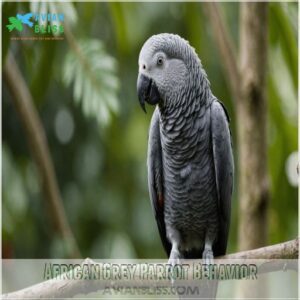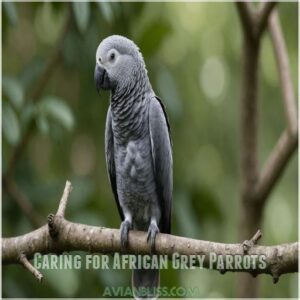This site is supported by our readers. We may earn a commission, at no cost to you, if you purchase through links.

Sporting striking silver feathers, a white face mask, and a bright red tail, this medium-sized bird is not just a looker but also a talker.
With a knack for bonding deeply with their human companions, they crave attention and play but value their alone time too.
Ready for a 60-year commitment? They’ll keep you on your toes with their need for mental stimulation and a balanced diet of pellets, fruits, and veggies.
Curious how these parrots rack up so many talking points?
Table Of Contents
- Key Takeaways
- Origins and Characteristics
- African Grey Parrot Behavior
- Types of African Greys
- Caring for African Grey Parrots
- African Grey Lifespan
- Health and Wellbeing
- Communication and Intelligence
- Socialization and Training
- Conservation Status
- Is The African Grey Parrot Right for You?
- Frequently Asked Questions (FAQs)
- Are African grey parrots good pets?
- Can African gray parrots talk?
- What are the cons of African grey parrots?
- What is the lifespan of an African grey parrot?
- How do African Greys interact with other pets?
- What is the cost of owning an African Grey?
- Can African Greys be left alone during vacations?
- How do I choose toys for an African Grey?
- Are African Grey parrots prone to specific diseases?
- Conclusion
Key Takeaways
- You’ll find African Grey Parrots to be intelligent and sociable, with impressive vocal abilities, mimicking up to 1,000 words accurately.
- Providing mental stimulation and social interaction is crucial to prevent boredom and destructive behaviors such as feather plucking or screeching, as parakeets can experience severe loneliness and stress if left without a companion or enriching environment understanding parakeet loneliness.
- Their lifespan ranges between 40 to 60 years, requiring a long-term commitment and consistent care with a balanced diet and regular vet check-ups.
- It’s important to arrange trusted caregivers during vacations, as these parrots need ongoing social interaction to stay happy and healthy.
Origins and Characteristics
You’ll discover that African Grey Parrots, scientifically known as Psittacus erithacus, originate from equatorial Africa, boasting striking silver feathers and a characteristic white face mask.
African Grey Parrots are known for their intelligence and surprisingly sweet personalities, making them fascinating and, let’s be honest, sometimes hilariously mischievous companions.
Physical Features
Imagine this: your African Grey Parrot, dazzling everyone with its striking physical features.
These birds have a medium size, measuring around 19 to 20 inches long, and typically weigh between 1.2 pounds, as seen in African Grey characteristics.
These beauties boast sleek, silver feathers that shimmer in the sunlight. Their beak shape is distinctly curved, designed for cracking nuts with ease. A bright red tail adds a striking accent. You’ll also notice their expressive eye color, typically a warm, intelligent yellow.
- Admire those vibrant tails.
- Revel in their expressive eyes.
- Marvel at those sleek feathers.
Personality Traits
As African Grey Parrots possess striking physical features, their personality is equally engaging.
You’re dealing with an affectionate, playful, and intelligent bird.
Their social nature makes them curious companions while their sensitivity demands gentle care.
These amazing talking birds thrive on attention, infusing your day with clever antics.
Understanding their behavior is key, as African Greys’ actions can be influenced by their natural instincts and mental well-being, which can be shaped through positive reinforcement techniques. Yet, their independent streak requires balanced bird care, blending interaction and alone time for ideal bird behavior and training success.
African Grey Parrot Behavior
When observing an African Grey Parrot, you’ll quickly notice their incredible intelligence, which rivals that of a young child, along with their playful nature and remarkable vocal mimicry.
These birds form strong bonds with their owners, but their sensitivities can lead to challenges if they’re not given enough attention or stimulation.
High Intelligence
Exploring an African Grey parrot’s intelligence can be like unraveling a mystery.
They’ve been known to tackle puzzles, showcasing advanced problem-solving skills.
Their cognitive prowess shines in studies, where they exhibit abilities akin to a five-year-old child.
Owning one means embracing training challenges and ethical ownership, as these birds require stimulation through bird toys and activities to maintain robust bird health.
Vocal Mimicry
Ever heard an African Grey Parrot mimic your ringtone?
Their vocal mimicry is perfect for turning heads and sparking conversation.
These skilled performers excel in parrot speech, imitating everything from doorbells to human phrases.
It’s a clear indication of their incredible language learning ability.
Just remember, a happy, engaged pet bird thrives, so keep those word repetitions and sound imitations coming!
Strong Bonds
While African Greys are famous for their vocal mimicry, they’re also masters at forming strong bonds.
You can find helpful resources for training your African Grey parrot to build a strong bond with you, such as training tools and tips.
Bonding with your African Grey means overcoming relationship challenges, with trust training at the heart of it.
These parrots, hailing from central and west Africa, often pick a “favorite” human.
Engage with them consistently, offering enrichment for bonding and building a strong connection.
Playful Nature
These clever birds aren’t just brainy; they’re playful too!
Their fun-loving side shines through in various ways.
You’ll find your African Grey enjoys:
- Interactive toys that challenge their minds.
- Social games like hide-and-seek (with their favorite treats!).
- Enrichment activities, like foraging for oil palm nuts (a favorite!).
- Playtime ideas that involve mimicking your actions – they’re natural mimics!
Remember, a bored grey is a grumpy grey, so keep those playtime ideas coming!
Sensitive
After enjoying their playful antics, you’ll notice how sensitive African Grey parrots are, and it’s important to understand that their fear response, like many birds, is triggered by unpredictable movements and noises, such as those associated with human behavior and bird fear.
Stress and noise sensitivity can overwhelm them.
Place their cage in a calm spot, away from loud disturbances, to help them relax.
Gentle handling is key; rushing can leave them ruffled.
Being mindful of environmental factors helps create a happy, harmonious relationship with your feathered friend.
Types of African Greys
You’ll encounter two main types of African Grey parrots: the larger Congo African Grey, known for its lighter gray feathers and black beak, and the smaller Timneh African Grey, which sports darker plumage and a horn-colored upper beak.
Each possesses remarkable intelligence, making them both excellent companions if you’re okay with a bird that might outsmart you on occasion.
Congo African Greys
Imagine owning a Congo African Grey, the largest of its kind, with light gray feathers and a commanding presence.
To keep your Congo Grey engaged and stimulated, consider investing in a variety of African Grey Parrot Toys.
It captivates with its incredible intelligence and knack for mimicry.
When setting up your Congo Grey housing, aim for spacious quarters, training should promote engagement and bonding.
For a happy bird, vary its diet and encourage interaction.
You’ve got a lifelong companion!
Timneh African Greys
Thinking about Timneh African Greys? These fascinating birds are smaller than their Congo cousins, boasting darker gray feathers and a horn-colored beak.
If you’re considering other vibrant parrot options, learn more about the physical differences between jenday conure vs sun conure.
Here’s what you need to know:
- Personality: They’re social yet independent, offering a perfect mix.
- Lifespan: Expect 40 to 60 years of companionship.
- Care Tips: Provide mental challenges to keep them sharp and happy.
Compare Timneh vs. Congo to see which fits you best!
Caring for African Grey Parrots
Caring for African Grey parrots involves providing a spacious cage, a balanced diet, and plenty of social interaction to keep them engaged.
You’ll need to be prepared for their intelligent and social nature with mental stimulation like toys and training to prevent boredom and promote well-being.
Proper Housing
You’ve just seen the beauty of Congo and Timneh African Greys.
Now, think about their home: a spacious cage is like a castle—2 feet wide, 3 feet tall, with enriching toys and safe accessories.
Place it in a calm area.
| Factor | Recommendation |
|---|---|
| Cage Size | 2×2 feet footprint |
| Cage Accessories | Perches, swings |
| Enrichment Items | Puzzle toys, mirrors |
| Location | Quiet, well-lit corner |
Diet and Nutrition
Now that your parrot’s home is set up, let’s talk food!
A good diet is key.
High-quality pellets form the base, supplemented with fresh fruits and veggies.
Think of it like a balanced meal for your feathered friend.
Seeds should be treats, not staples.
Monitor for food allergies and adjust accordingly.
Remember, dietary changes should be gradual to avoid upset tummies.
Nutritional supplements might be needed, depending on your bird’s needs.
Social Interaction
Getting to know your African Grey’s flock dynamics and bonding rituals is essential.
These intelligent birds thrive on social interaction, recognizing their place in the social hierarchy.
Encourage their communication styles with a mix of:
- Daily conversations
- Interactive games
- Group playtime
- Gentle petting
Embrace these rituals, and you’ll build a trusting, talkative companion.
Mental Stimulation
When finding the right balance for your African Grey’s mental stimulation, toy rotation, puzzle feeders, and interactive games can work wonders.
Combine these with foraging activities to keep them engaged.
With these enrichment ideas, you’re on the road to a happy, healthy parrot.
| Activity | Benefits | Frequency |
|---|---|---|
| Toy Rotation | Prevents boredom | Weekly |
| Puzzle Feeders | Encourages problem-solving | Daily |
| Interactive Games | Boosts social interaction | Daily |
| Foraging Activities | Stimulates natural behavior | Several times a week |
| Enrichment Ideas | Overall enrichment | Ongoing |
African Grey Lifespan
You might be surprised to learn that African Grey parrots can live between 40 to 60 years in captivity, sometimes reaching the impressive age of 80 with proper care.
By ensuring a balanced diet, regular veterinary check-ups, and plenty of mental stimulation, you can maximize your parrot’s lifespan, making them a truly long-term companion.
Factors Affecting Lifespan
You might wonder what affects your African Grey’s lifespan.
Several key factors play a role:
- Diet: Provide a balanced diet for good health.
- Genetics: Like us, genetics influence their longevity.
- Environment: A clean, safe habitat is essential.
- Stress: Minimize stress to boost well-being.
- Vet care: Regular vet visits catch issues early.
Average Lifespan in Captivity
Imagine you own an African Grey parrot—these brilliant birds can charm you for decades.
Their average lifespan in captivity is 40 to 60 years, depending on factors such as a healthy diet with essential antioxidants and fiber, health, and environment.
A remarkably long commitment!
Here’s a quick snapshot:
| Aspect | Details | Importance |
|---|---|---|
| Lifespan | 40 to 60 years | Long-term care |
| Diet | Balanced nutrition | Essential for life |
| Environment | Stimulating space | Mental enrichment |
Maximizing Lifespan
To help your African Grey parrot live a long, healthy life, provide a balanced diet rich in fruits, vegetables, and pellets.
Regular vet care is essential to catch any health issues early.
Enrichment through toys and social interaction prevents boredom and stress.
Avoid breeding stresses unless necessary, as these can impact their lifespan.
Happy parrots thrive longer!
Health and Wellbeing
Your African Grey’s health is essential for their long and happy life, so let’s explore common illnesses, preventative care, and when a vet visit is necessary.
Understanding their health needs, from diet to potential problems, will help you guarantee your feathered friend thrives for decades to come, maybe even outliving your favorite armchair!
Signs of Illness
Spotting illness in your African Grey can feel like unraveling a mystery.
Look for changes that stir concern:
- Feather plucking, which could be a scream for help.
- Noticeable lethargy, the kind where lively play turns into sluggish lounging.
- Appetite changes that seem out of character.
- Alterations in droppings, perhaps a sign of tummy troubles.
Keep these clues on your radar!
Common Health Issues
Your African Grey parrot’s health might occasionally throw a spanner in the works, with common issues including feather plucking, respiratory infections, and dietary deficiencies leading the pack.
They can also face fungal infections and pesky parasites.
Keep an eye out for these potential problems; remember, a well-rounded diet and a clean environment are your best allies in maintaining their vibrant health.
Veterinary Care
Noticing a few health issues is important – a parrot not eating and sleeping a lot can be a sign of illness or stress, so recognizing these signs is essential.
That’s the perfect cue to chat with avian specialists.
Regular check-ups are part of preventative care, keeping your African Grey chirping happily.
Be aware of common illnesses they might face.
Understanding emergency procedures means you can act swiftly when needed.
Communication and Intelligence
You’ll be amazed at how the African Grey Parrot can mimic human speech, with some birds learning to use over 1,000 words and phrases accurately.
Their intelligence is comparable to that of a five-year-old child, making them outstanding companions as well as fascinating subjects of scientific study.
Vocal Abilities
African Grey parrots excel at vocal mimicry, effortlessly imitating a wide range of sounds.
Their extraordinary ability for sound recognition and language acquisition often leaves owners in stitches.
Though you might be tempted to think they’re chatting away freely, don’t let them pull the wool over your eyes!
- Charming chatterbox antics
- Mimics household sounds
- Masters of parrot communication
Understanding Human Speech
Imagine a clever bird that doesn’t just mimic but truly understands.
The African Grey parrot, renowned for its speech comprehension and communication skills, goes beyond simple vocal mimicry.
It recognizes words and phrases, responding appropriately, which is a clear indication of its language learning abilities.
This feathered friend might even surprise you by asking for a snack or imitating your laugh!
Cognitive Skills
Their ability to understand human speech is just the tip of the iceberg!
These clever birds also show impressive problem-solving skills, a remarkable memory, and even some signs of self-awareness.
Language acquisition comes naturally; they can learn hundreds of words.
Think of it: your parrot might even use tools!
It’s fascinating to watch their cognitive abilities unfold.
Studies show their intelligence rivals that of a young child.
Socialization and Training
To successfully raise a happy African Grey parrot, understanding the root causes of aggression, such as hormonal changes and breeding behavior as seen in parakeets why is my male parakeet attacking my female, is crucial to prevent similar issues. You’ll need to focus on early socialization and consistent training, which are essential to preventing behavioral problems like screeching or aggression.
With their intelligence rivaling that of a five-year-old child, these parrots thrive on interactive play, engaging tasks, and a structured environment that keeps their curious minds occupied.
Importance of Socialization
Blue parakeets can learn up to 100 words or more, and they use talking as a way to mimic human speech like blue parakeets. While you admire their ability to mimic human speech, don’t overlook how important socialization is.
It prevents aggression, strengthens bonds, and fosters trust.
Here’s how:
- Spend time together to bond with your parrot.
- Introduce them to other birds for group living.
- Use playful interactions to build trust.
- Observe unique expressions for personalized socialization techniques.
Training Techniques
Training an African Grey with clicker training can be a breeze if you use positive reinforcement.
Start with target training to guide your bird, leveraging shaping behavior to teach new tricks.
Providing a balanced diet with high-quality Parrot Food Options is essential for their growth and development.
Puzzle your parrot with problem-solving games, which are both effective and fun.
Consistent, patient practice strengthens your pet’s skills and your bond, creating a harmonious, chatty household.
Preventing Behavioral Problems
To prevent behavioral problems in your African Grey, focus on socialization and training, which curb boredom and enhance enrichment.
Think of your parrot as a demanding roommate needing 1) varied toys for mental stimulation, 2) daily attention filled with chatter and play, 3) a balanced diet to keep them chirpy, and 4) consistent training to improve social bonds.
Conservation Status
You might be surprised to learn that the African Grey Parrot is listed as endangered due to threats like habitat loss and illegal trade.
Fortunately, conservation efforts and responsible ownership practices are helping to protect these intelligent birds for future generations.
Threats to Wild Populations
After bonding with your feathered friend, understanding the signs your bird trusts you, such as relaxed posture and feather position signs of trust in birds, are crucial in creating a strong and healthy relationship. African Grey parrots face serious threats in the wild.
Habitat loss from deforestation disrupts their homes, while illegal trade strips their flocks bare.
As climate change alters habitats, poaching poses a continual menace.
Imagine these intelligent birds struggling against such odds, their melodic voices silenced, the vibrant feathers unseen by future generations.
Conservation Efforts
Facing these threats, conservationists are working hard!
Habitat restoration projects are underway, combating deforestation.
Sustainable logging practices are being promoted to protect their homes.
Captive breeding programs help boost populations, while public awareness campaigns educate people about the illegal trade impact.
These efforts are essential for the survival of these amazing birds.
It’s a team effort to save these clever creatures!
Responsible Ownership
Conserving African Grey parrots isn’t just about saving a species; it’s about understanding your role in their care.
As a responsible owner, choose only birds from reputable sources, ensuring the cage size accommodates their needs.
Explore training tips and vet visits, and prioritize enrichment ideas.
Lifespan considerations remind you of the enduring commitment required.
Is The African Grey Parrot Right for You?
Considering an African Grey Parrot as a pet means preparing for a long-term commitment, as these intelligent birds can live for up to 60 years and require extensive interaction daily.
You’ll need to weigh the pros and cons of their care needs and consider if you’re ready to provide the mental stimulation and attention required to keep them healthy and happy.
Pros and Cons of Ownership
Weighing the pros and cons of owning an African Grey parrot? They’re intelligent, offering excellent companionship, but they come with a hefty cost and significant time commitment.
These birds need constant attention, can be noisy, and might indulge in destructive behavior if bored.
Training them requires patience and skill—imagine the challenge of teaching a toddler to whistle!
Preparing for Ownership
Preparing to own an African Grey Parrot involves understanding its unique needs.
Consider these essentials:
- Cage Size: Opt for spacious housing to accommodate their active nature.
- Cost Estimate: Factor in food, toys, and vet expenses.
- Time Commitment: Expect to spend quality time daily for socialization and care.
- Training Needs: Focus on mental and physical activities to keep them engaged.
Long-term Commitment
Buying an African Grey requires more than just enthusiasm.
You must consider financial preparedness, time investment, and ethical implications.
These parrots live long, often outlasting their owners, with some parrot species known to live up to 60 years or more, as seen in longest-living birds.
They need dedicated care, spacious homes, and social interaction.
Here’s a snapshot of key factors:
| Aspect | Considerations | Commitment |
|---|---|---|
| Financial | Cost of care | Ongoing expenses |
| Time | Daily engagement | Minimum 2 hours/day |
| Space | Cage and play area | 3x3x6 ft cage minimum |
Frequently Asked Questions (FAQs)
Are African grey parrots good pets?
Sure, African grey parrots can make excellent pets due to their intelligence and sociable nature.
They’re known for mimicking sounds and human speech, but they require significant attention, mental stimulation, and long-term commitment.
Can African gray parrots talk?
African gray parrots can talk, often mimicking human speech with impressive accuracy.
African gray parrots are incredibly intelligent, rivaling the intelligence of a five-year-old child.
This allows them to learn up to 1,000 words and use them contextually.
Isn’t that amazing?
What are the cons of African grey parrots?
With cognitive skills similar to a five-year-old child, African grey parrots need constant mental stimulation and social interaction.
Without it, they can become bored and noisy, potentially developing destructive behaviors like screeching or feather plucking.
What is the lifespan of an African grey parrot?
You can expect an African grey parrot to live between 40 and 60 years in captivity.
Give or take a few more years with excellent care, their lifespan requires a long-term commitment, making them lifelong companions.
How do African Greys interact with other pets?
Introducing other pets requires careful, gradual introductions. Supervise interactions closely; some Greys bond well, others don’t. Patience is key for a harmonious household.
What is the cost of owning an African Grey?
The cost of owning an African Grey parrot ranges from $500 to $4,
You’ll also need to factor in long-term expenses, including a spacious cage, toys, quality food, regular veterinary care, and time for social interaction.
Can African Greys be left alone during vacations?
Statistics reveal that African Greys can mimic up to 1,000 words, highlighting their intelligence.
It’s important to arrange trusted caregivers during vacations as these social parrots need interaction, to prevent loneliness and potential behavioral issues.
How do I choose toys for an African Grey?
Choose toys that stimulate African Greys’ intelligence, like puzzle toys and foraging toys.
Make sure they’re durable and safe, avoiding small parts.
Regularly rotate these toys to keep your parrot engaged and mentally stimulated, preventing boredom.
Are African Grey parrots prone to specific diseases?
African Grey parrots can suffer from specific health issues like psittacine beak and feather disease, respiratory infections, and calcium deficiency.
Ensuring a varied diet, regular vet check-ups, and a clean environment helps keep them healthy.
Conclusion
Brilliant birds bounded by brains and beauty, African Grey Parrots bring both challenges and charm to your life.
Providing proper care—from diet and housing to emotional engagement—ensures a thriving pet, making the journey rewarding.
Embrace their playful personalities and profound intelligence by offering stimulating environments and training.
If you’re ready for the responsibility, these feathered friends deliver lifelong companionship and endless amazement.
So, consider the African Grey Parrot, and begin an enriching avian adventure.











0 Comments